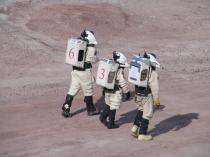Mars project to simulate radiation exposure

Monitoring radiation from solar flares to ensuring that fellow crew members on the surface receive ample warning is only one of the tasks for Irene Schneider Puente, graduate student in geosciences at Penn State, as a member of the Crew 61, a two-week simulation of Martian exploration.
Scheduled for two weeks in April, Crew 61 is sponsored by the NASA Spaceward Bound Program and the Mars Society and funded by NASA's Exploration Systems Mission Directorate. The last of the 2006-2007 season's missions, the focus of the two weeks is "Emergency Preparedness” and includes simulation and protocol development for EVA (Extravehicular Activity) emergencies, radiation poisoning prevention, EVA radiation emergency protocols and an emergency air quantity/location study.
The five crew members from industry and academia and from the U.S., Peru, Belgium and Spain will live in a two-story, 26.5-foot diameter circular habitat called the Mars Desert Research Station located in the Utah desert.
"This is a unique mission, the first dedicated to emergency preparedness," says Schneider. "I wanted to develop the emergency at radiation protocols on this mission because it is one of the problems with Lunar and Mars manned exploration."
Schneider will monitor three hypothetical different radiation warning systems during the mission. One, located outside the habitat, is an immediate gauge of radiation in the area. Monitors in orbiting satellites will supply information on the direction of the solar storm, and information from the satellites orbiting the sun will provide the third set of information.
All the monitors also record galactic cosmic radiation, the general background radiation of the universe. Above that, the detectors will show evidence of high-energy protons, helium atoms or electrons produced by solar flares.
"These particles travel like bullets and their effects on humans and electronics are mission critical," says Schneider. "The solar monitors can tell us that there is a flare, the orbiting monitors can indicate if the radiation will hit Mars and the local monitors will signal danger for the crew."
Depending on where Mars is in its orbit – how close or distant from the sun – the warning times will range from 30 minutes to three days.
Schneider's job is to run simulations of a variety of possible situations, decide the proper response and evaluate the outcome and gravity of the situation. Radiation poisoning from these fast solar particles can be lethal to human crews. A dose of 500 rads or more will kill a human in two to three hours. A lesser dose can cause acute radiation sickness that would be lethal in weeks if not properly treated.
Solar flare radiation is not a problem on Earth because the Earth's magnetic field and to some extent, its atmosphere, prevent most of the radiation from reaching the surface. Mars, lacking a global magnetic field and with a much thinner atmosphere, is not protected from the effects of solar storms.
Some of the scheduled operational protocols in the simulations are simple. If an EVA is planned and there is an indication that a solar flare will occur during that period, Schneider will simply tell the crew and the EVA will be cancelled or aborted. If a solar flare is predicted while the three members of the crew on EVA are only a short distance away, the crew will be recalled immediately. During the simulation, she will assume that the Mars habitat is shielded from the effects of solar flares and supplies a safe haven.
If the EVA crew is too far away to return, they would be told to either erect a portable shelter or create or find some type of natural shelter previously established. However, if shelter is not found, the simulation turns into an evacuation drill to return the injured crew member or members to the habitat.
Source: Penn State





















